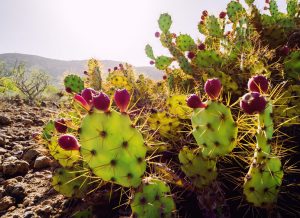 Few plants are as versatile as the prickly pear cactus, known as nopal in Spanish. Its delicious fruits are roasted, grilled, broiled, eaten raw, pureed, and juiced, and it’s the starring ingredient in a range of consumer products—from shampoo to medications. The humble cactus was revered by the ancient Aztecs—there’s even a cacti legend associated with the ruins of Tenochtitlan (a must-see sight for any visitor to Mexico City). But recently, it was discovered that the prickly pear cactus might have yet another use—a renewable energy source of the future.
Few plants are as versatile as the prickly pear cactus, known as nopal in Spanish. Its delicious fruits are roasted, grilled, broiled, eaten raw, pureed, and juiced, and it’s the starring ingredient in a range of consumer products—from shampoo to medications. The humble cactus was revered by the ancient Aztecs—there’s even a cacti legend associated with the ruins of Tenochtitlan (a must-see sight for any visitor to Mexico City). But recently, it was discovered that the prickly pear cactus might have yet another use—a renewable energy source of the future.
Turning green cacti into green energy
On the south side of Mexico City, a neighborhood called Milpa Alta features an impressive expanse of 7,000 acres of prickly pear cactus, not far from a dormant volcano called Teuhtli. The land has been farmed for more than 20 years. Each year, it produces about 200,000 tons of cacti, and about 10 tons of that is waste. Every morning, workers who arrive at the busy cactus market spend some time cleaning up the waste left there the previous day.
Energy and Environmental Sustainability, known locally as Suema, is a green energy startup that got the bright idea to invent a biogas generator capable of turning cactus waste into renewable energy. The generator processes the waste with the addition of a bacterial blend. The mix is heated to 131 degrees Fahrenheit, and biogas is the result.
Cactus farmers and vendors have eagerly embraced the concept. The generator will soon be capable of producing 45,000 gallons of biogas each day. The Mexico City government hopes to expand the project to house a generator at each of the area’s 300-plus cactus markets.
Legends of Tenochtitlan
The prickly pear cactus has been vital to the way of life for Mexico’s communities, from the ancient Aztecs to today. Legend has it that the first prickly pear cactus sprang from the heart of Copil, who was the son of the moon, Malinalxochitl. Copil attempted to kill his uncle, the sun, called Huitzilopochtli. The sun triumphed over Copil, and took out his nephew’s heart and buried it. The next day, the heart grew the first cactus. The thorns are symbolic of Copil’s warrior spirit, and the beautiful red flowers are reflective of Copil’s love for his mother, whom he had been defending when he attacked his uncle.
Today, visitors to Mexico flock to the ancient ruins at Tenochtitlan. Archaeologists have dated this thriving Aztec city to between 1325 and 1521 A.D. Hundreds of thousands of people lived there, surviving thanks to the advanced system of canals and causeways. The city was destroyed by Spanish conquistador Hernan Cortes in 1521, and it now rests beneath modern-day Mexico City.
Visitors to Mexico City should stop by the National Museum of Anthropology, which houses the famed Aztec sun stone, before heading over to the Templo Mayor, which is a massive Aztec site. Most recently, in the summer of 2017, archaeologists have discovered a major Aztec temple in downtown Mexico City. You can see the excavation project just behind the Roman Catholic cathedral.
Book your next trip to Mexico City with Sea Side Reservations. We connect travelers to reputable and luxurious accommodations throughout the country.
More info on the prickly pear cactus:
- Mexico’s prickly pear cactus: energy source of the future? https://www.timeslive.co.za/news/sci-tech/2017-08-17-mexicos-prickly-pear-cactus-energy-source-of-the-future/
- Prickly Pear Cactus, https://www.desertusa.com/cactus/prickly-pear-cactus.html


